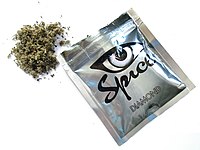
Structural States of RORγt: X‐ray Elucidation of Molecular Mechanisms and Binding Interactions for Natural and Synthetic Compounds
Sign Up to like & getrecommendations! Published in 2017 at "ChemMedChem"
DOI: 10.1002/cmdc.201700278
Abstract: The T‐cell‐specific retinoic acid receptor (RAR)‐related orphan receptor‐γ (RORγt) is a key transcription factor for the production of pro‐inflammatory Th17 cytokines, which are implicated in the pathogenesis of autoimmune diseases. Over the years, several structurally… read more here.
Keywords: natural synthetic; synthetic compounds; inverse agonists; structural states ... See more keywords

Discovery of endogenous inverse agonists for G protein-coupled receptor 6.
Sign Up to like & getrecommendations! Published in 2019 at "Biochemical and biophysical research communications"
DOI: 10.1016/j.bbrc.2019.12.004
Abstract: The orphan G protein-coupled receptor 6 (GPR6) is highly expressed in the striatum and has been linked to multiple striatal pathologies. The identification of endogenous ligands and their mechanisms of action at GPR6 will help… read more here.
Keywords: endogenous inverse; inverse agonists; dopamine; protein coupled ... See more keywords

Alkylphenol inverse agonists of HCN1 gating: H‐bond propensity, ring saturation and adduct geometry differentially determine efficacy and potency
Sign Up to like & getrecommendations! Published in 2019 at "Biochemical Pharmacology"
DOI: 10.1016/j.bcp.2019.02.013
Abstract: Graphical abstract Figure. No caption available. Background and purpose: In models of neuropathic pain, inhibition of HCN1 is anti‐hyperalgesic. 2,6‐di‐iso‐propyl phenol (propofol) and its non‐anesthetic congener, 2,6‐di‐tert‐butyl phenol, inhibit HCN1 channels by stabilizing closed state(s).… read more here.
Keywords: potency; bond; ring saturation; inverse agonists ... See more keywords

Structure-activity relationship studies and pharmacological characterization of N5-heteroarylalkyl-substituted-2-(2-furanyl)thiazolo[5,4-d]pyrimidine-5,7-diamine-based derivatives as inverse agonists at human A2A adenosine receptor.
Sign Up to like & getrecommendations! Published in 2018 at "European journal of medicinal chemistry"
DOI: 10.1016/j.ejmech.2018.06.020
Abstract: This paper describes the synthesis and characterization of N5-(hetero)arylalkyl-substituted-thiazolo [5,4-d]pyrimidine-5,7-diamine derivatives (4-19) as novel human (h) A2A adenosine receptor (AR) inverse agonists. Competition binding and cyclic AMP assays indicate that the examined compounds behave as… read more here.
Keywords: human a2a; thiazolo pyrimidine; inverse agonists; pyrimidine diamine ... See more keywords

Discovery and Structure-Based Design of Potent Covalent PPARγ Inverse-Agonists BAY-4931 and BAY-0069.
Sign Up to like & getrecommendations! Published in 2022 at "Journal of medicinal chemistry"
DOI: 10.1021/acs.jmedchem.2c01379
Abstract: The ligand-activated nuclear receptor peroxisome-proliferator-activated receptor-γ (PPARG or PPARγ) represents a potential target for a new generation of cancer therapeutics, especially in muscle-invasive luminal bladder cancer where PPARγ is a critical lineage driver. Here we… read more here.
Keywords: ppar; inverse agonists; ppar inverse; 4931 bay ... See more keywords

6-Benzhydryl-4-amino-quinolin-2-ones as Potent Cannabinoid Type 1 (CB1) Receptor Inverse Agonists and Chemical Modifications for Peripheral Selectivity.
Sign Up to like & getrecommendations! Published in 2018 at "Journal of medicinal chemistry"
DOI: 10.1021/acs.jmedchem.8b01467
Abstract: A novel series of 6-benzhydryl-4-amino-quinolin-2-ones was discovered as cannabinoid type 1 receptor (CB1R) inverse agonists based on the high-throughput screening hit, compound 1a. Structure-activity relationships were studied to improve in vitro/in vivo pharmacology and restrict… read more here.
Keywords: amino quinolin; cannabinoid type; benzhydryl amino; quinolin ones ... See more keywords

2-Phenyl-1H-pyrrole-3-carboxamide as a New Scaffold for Developing 5-HT6 Receptor Inverse Agonists with Cognition-Enhancing Activity
Sign Up to like & getrecommendations! Published in 2021 at "ACS Chemical Neuroscience"
DOI: 10.1021/acschemneuro.1c00061
Abstract: Serotonin type 6 receptor (5-HT6R) has gained particular interest as a promising target for treating cognitive deficits, given the positive effects of its antagonists in a wide range of memory impairment paradigms. Herein, we report… read more here.
Keywords: cognition enhancing; inverse agonists; phenyl pyrrole; ht6r ... See more keywords

Development of Novel δ Opioid Receptor Inverse Agonists without a Basic Nitrogen Atom and Their Antitussive Effects in Mice.
Sign Up to like & getrecommendations! Published in 2019 at "ACS chemical neuroscience"
DOI: 10.1021/acschemneuro.9b00368
Abstract: Our previous results showed that NTI derivatives with certain types of electron-withdrawing groups as an N-substituent showed δ opioid receptor (DOR) inverse agonistic activities. We therefore synthesized N-acylated NTI de-rivatives 3a-e and observed that N-benzoyl… read more here.
Keywords: opioid receptor; inverse agonists; basic nitrogen; dor ... See more keywords

Discovery of PEGylated 6-Benzhydryl-4-amino-quinazolines as Peripherally Restricted CB1R Inverse Agonists.
Sign Up to like & getrecommendations! Published in 2020 at "ACS medicinal chemistry letters"
DOI: 10.1021/acsmedchemlett.0c00495
Abstract: The 6-benzhydryl-4-amino-quinolin-2-ones are peripherally restricted CB1 receptor inverse agonists (CB1RIAs) that have been reported to attenuate obesity and improve insulin sensitivity in the diet-induced obese (DIO) mouse model. However, chronic dosing of select compounds from… read more here.
Keywords: peripherally restricted; inverse agonists; benzhydryl amino;

Novel Tricyclic Pyroglutamide Derivatives as Potent RORγt Inverse Agonists Identified using a Virtual Screening Approach.
Sign Up to like & getrecommendations! Published in 2020 at "ACS medicinal chemistry letters"
DOI: 10.1021/acsmedchemlett.0c00496
Abstract: Employing a virtual screening approach, we identified the pyroglutamide moiety as a nonacid replacement for the cyclohexanecarboxylic acid group which, when coupled to our previously reported conformationally locked tricyclic core, provided potent and selective RORγt… read more here.
Keywords: virtual screening; ror; screening approach; inverse agonists ... See more keywords

Advances in Medicinal Chemistry of Estrogen-related receptor alpha (ERRα) inverse agonists.
Sign Up to like & getrecommendations! Published in 2023 at "Current topics in medicinal chemistry"
DOI: 10.2174/1568026623666230515145822
Abstract: Estrogen-related receptor alpha (ERRα), a member of the nuclear receptor superfamily, is strongly expressed in breast cancer cells. Its overexpression is associated with poor prognosis in triple-negative breast cancer (TNBC). ERRα expression could be inhibited… read more here.
Keywords: estrogen related; inverse agonists; chemistry; receptor ... See more keywords